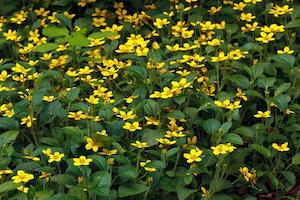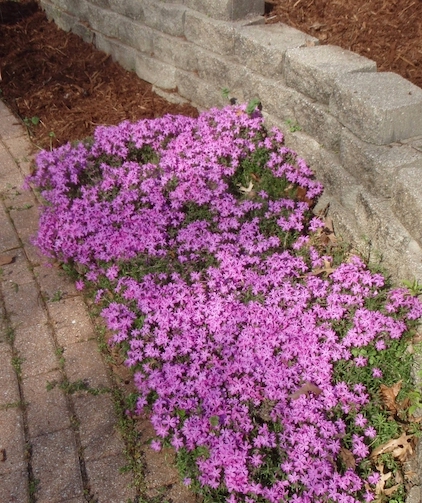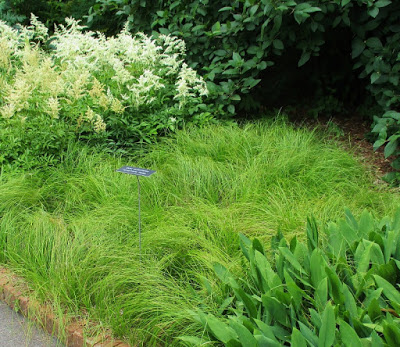Ground Cover or Cover Your Ground
By Jennifer Naughton, Fairfax Master Gardener

Amsonia hubrichtii
To preserve land integrity, small but united efforts across residential lot lines can make a difference. Homeowners, more than farms or industry, hold underutilized power in changing environmental practices harming American land. Turfgrass is the most irrigated crop in America with billions of pounds of fertilizer and pesticide utilized per year and billions spent on lawn care. If you add to that number, dollars spent on irrigating, fertilizing and mulching ornamental garden beds, it is clear that the process of caring for our residential land is wasteful and full of misuse. All this effort, time and money to send clean water with excess chemicals down the drain as toxic run-off into our waterways, harms life on land and water alike.

Chrysogonum virginianum – a native

Phlox subulata
Choices for ground cover are endless and depend on environment and aesthetic needs. To keep hold of the soil in your yard, provide evergreen cover and integrate a first layer of natives in your landscape, consider the following.
With its cheerful, upright yellow April bloom, Packera aurea is adaptable, but best suited for medium to wet soil, with sun to part shade. Its thick foliage hints at its aggressive nature, so contain it in an area with paved borders or with a watchful eye. Another spring bloomer with a shorter, yellow daisy-like flower and more easily controlled is Chrysogonum virginianum, which also forms a dense mat and works well in part shade to shade, and medium to wet soils. If you are lucky and it is not too hot, Chrysogonum will flower from early spring to summer. Both plants are recommended for rain gardens.

Carex Rosa
Some favorite ground covers are sedges. Although flowering is insignificant, they provide a tidy appearance around other blooming perennials and offer a chance to play with foliage hue and texture. Some have yellow or blue tones, some are broad-leaved, and others are wispy and light in the garden. An added bonus is the root mass and depth that assist rainwater in infiltrating the soil. Carex strica is one such example, boasting more biomass below ground than above. Its fountain-like habit is 1 to 3 feet tall, and it easily naturalizes and prevents erosion. A smaller, option is Carex rosea whose 1-foot-tall form tolerates both dry and moist conditions from full sun to partial shade. Carex pensylvanica, the smallest and most adaptable, grows in sun to shade, dry to moist, as it naturalizes and enriches the soil. C. pensylvanica can serve as a substitute for turfgrass and fills in an open space nicely with its rhizomatous and self-seeding nature.

Carex pensylvanica
Covering your ground can feel like a daunting task. The expense of planting enough ground cover to blanket garden beds or substitute turfgrass is initially expensive. There are economical options to make this work. Local native plant nurseries sell trays of plugs or purchase larger gallon-size plants and divide them into smaller clumps to stretch your dollar. Choose ground covers that spread and self-seed. Or dig up and exchange your profuse ground covers with a friend or at a plant swap.
The positive impact on the environment and the aesthetic of creating space as nature intended holds intrinsic value. That initial layer in the landscape, ground cover, is a fundamental first step in creating a healthy and diverse ecosystem in your own yard. Be generous with it and you’ll reap rewards. Peel back a corner and take a look at the rich dirt beneath. It’s your land, it’s our land, a precious and dwindling resource.
References
Groundcovers: Lush Carpet For Your Garden, Elaine Homstad, Fairfax Master Gardeners
Earth Sangha Wild Plant Nursery, Springfield, VA
Watermark Woods Native Plants, Hamilton, VA
Biggest irrigated crop? The American lawn, Michigan Farm News. October 10, 2016
From Lawn to Meadow, Pennsylvania Land Trust Association
Illinois Native Plant Guide – Root Systems, U.S. Department of Agriculture, Illinois
The Lawn is the Largest Irrigated Crop in the USA, UCSB Geography, Bill Norrington
Lawns vs Crops in the Continental U.S., Francie Diep, Scienceline – a project of NYU’s science, health and environmental reporting program, July 3, 2011
Tussock Sedge, A Restoration Superplant?, University of Wisconsin, September 22, 2010